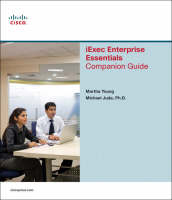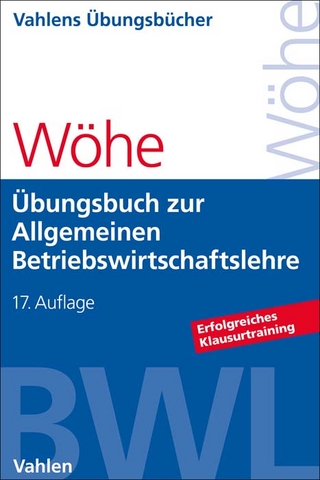
iExec Enterprise Essentials Companion Guide
Cisco Press (Verlag)
978-1-58713-219-3 (ISBN)
- Titel ist leider vergriffen;
keine Neuauflage - Artikel merken
Organized to fully align with the course’s online curriculum, this is the only authorized iExec textbook. You’ll begin by reviewing the global trends, opportunities, and strategic imperatives that now drive IT’s usage. Next, you’ll discover IT-enabled business strategies that increase productivity, efficiency, innovation, and profitability and learn how to trans-form any organization into an agile, high-performance Networked Virtual Organization (NVO). Through hands-on practice, you’ll learn how to assess and improve organizational readiness, enhance governance, Internet-enable internal and external processes, use portfolio management to plan business-driven IT investments, manage change, and more.
Martha L. Young, president and founder of Nova Amber, LLC, has more than 19 years of experience in the technology market, working and consulting with Fortune 500 companies such as Lockheed Martin and Coors Brewing Company. She holds a B.S. in international business from the University of Colorado.
Michael Jude, Ph.D., manages accounts for leading management solution vendors. He has more than 20 years of experience in telecommunications, as well as a Ph.D. in decision science from Walden University and an M.S. in engineering management and a B.S. in electrical engineering from the University of Colorado. Young and Jude are co-authors of The Case for Virtual Business Processes (Cisco Press).
• Master every topic and concept in the new Cisco Entrepreneur Institute’s iExec Enterprise Essentials curriculum
• Understand the global trends and business drivers behind today’s investments in IT and Internet technologies
• Build Networked Virtual Organizations that respond more quickly to customers, collaborate better with partners on value-added activities, and reduce cost by standardizing processes, data, and infrastructure
• Perform external and internal situation analysis, create an e-vision for success, and build an effective business case
• Implement strategic planning and portfolio management to create a successful Internet-enabled business roadmap
• Prioritize opportunities for process improvement using the Internet and IT
• Identify change management techniques that can reduce your risks
Category: Computers and Networking
Covers: Network Technology
Martha L. Young, president and founder of Nova Amber, LLC, has more than 19 years of experience in the technology market, working and consulting with Fortune 500 companies such as Lockheed Martin and Coors Brewing Company. She holds a B.S. in international business from the University of Colorado. Michael Jude, Ph.D., manages accounts for leading management solution vendors. He has more than 20 years of experience in telecommunications, as well as a Ph.D. in decision science from Walden University and an M.S. in engineering management and a B.S. in electrical engineering from the University of Colorado. Young and Jude are co-authors of The Case for Virtual Business Processes (Cisco Press).
Introduction xiv
Module 1 Strategic Imperatives 1
Global Trends and Strategic Imperatives 1
The Impact of the Internet on Global Productivity and Competitiveness 2
The Internet and Global Productivity 2
The Convergence of IT Standards and Productivity 6
The Internet and Public and Private Sectors 7
The Public Sector 9
The Internet and Global Trends 10
Addressing the Global Trends 11
Conclusion 12
Exercise 13
IT and Its Effect on the Organization 14
IT and the Organization 14
IT and Productivity 15
IT and Efficiency 15
What Is Innovation? 17
IT and Innovation 17
Innovation and Efficiency Case Example 18
IT, Efficiency, and Innovation 19
IT and Customer Satisfaction 20
IT and Quality 21
Conclusion 22
Market and Business Drivers 22
Market Efficiency and Business Efficiency 23
Drivers of Market Efficiency and Business Efficiency 24
Efficient and Inefficient Markets and Businesses 25
Business Scenario 28
Conclusion 30
External Integration and Business Value 30
External Integration 31
Conclusion 37
Summary 37
Module 2 Management Strategies 39
Management and Strategy Fundamentals 39
What Is Value? 40
The Value Chain 44
Cost Advantage and Competitive Differentiation 48
Out-Tasking and Outsourcing for Competitive Advantage 49
Tasking and Outsourcing Table 51
Case Studies 52
Case Study 1: In a Decidedly Low-Tech Business, CEMEX Has a Surprisingly High-Tech Workforce Customer View 53
Case 2: IBSG Helps FedEx with a New Generation Sales Force Automation Platform 56
Case 3: British Airways—Getting in Shape with eWorking 60
Conclusion 66
The Business Value Framework 66
Overview of the Business Value Framework 67
The First “D”: Financial Drivers 67
The Second “D”: Business Differentiators 69
The Third “D”: Improvement Disciplines 70
How Does It All Fit Together? 71
Conclusion 72
Networked Virtual Organizations 72
The Networked Virtual Organization 73
Strategy One: Customer Centricity 74
Strategy Two: Core Versus Context 75
Strategy Three: Continuous Standardization 75
Case Studies 76
Kennisnet Case Study 76
Centrelink 78
NVOs Delivering Returns 79
Module 3 Organizational Readiness 81
Introduction 81
What Is Organizational Readiness? 81
Leadership: The First Pillar of Organizational Readiness 82
Characteristics That Define IT-Savvy Leadership 83
Governance: The Second Pillar of Organizational Readiness 83
ICT-Centric Governance Characteristics 84
Competencies: The Third Pillar of Organizational Readiness 85
The Five Cs of Core Competencies 86
Technology: The Fourth Pillar of Organizational Readiness 87
IT-Ready Elements 88
What Makes Internet-Enabled Organizations Successful? 88
Formula for Success with IT 89
Value of Organization Readiness 91
Conclusion 92
IT Governance and Planning 92
IT Governance: What Is It? 93
The Role of IT and IT Governance 93
How to Manage Funding for IT Governance 94
IT Governance and Planning 94
Funding 95
Conclusion 100
Moving Toward Organizational Readiness 101
The Leadership Guide 101
Moving Toward Leadership Readiness 101
The Guidelines for Success 102
The Role of Leaders and Culture 102
Issues and Challenges 103
The Governance Guide 105
Moving Toward IT Governance Readiness 105
The Governance and Operations Framework 106
Issues and Challenges 106
Governance Best Practices 107
IT Governance Funding Options 107
Governance: A Best Practice Example Insert Case Study 108
PNB Paribas 108
The Competencies Guide 108
Moving Toward Competencies Readiness 109
Improving Performance and Outcomes 109
The Guidelines for Success 110
Competencies: A Best Practice Example 110
The General Electric (GE) Energy Initiative 110
The Technology Guide 110
Moving Toward Technology Readiness 111
Performance and Outcomes 111
Issues and Challenges 113
Best Practice List 113
Conclusion 115
Organizational Readiness Planning 115
Planning: The First Step to Improvement 115
Why Plan for Organizational Readiness? 115
Improving Organizational Readiness 116
Conclusion 117
Readiness Assessment and Plan Development 117
Why Assess Your Organizational Readiness? 118
Characteristics of Organizational Competencies 118
Tools for Assessing Organizational Readiness 119
Net Readiness Scorecard: What Do I Do with the Results? 121
Organizational Readiness Improvement Plan 123
Conclusion 124
Conclusion 124
Module 4 ICT Solutions 127
Understanding Internet-Enabled Solutions 127
Examining Workforce Optimization Solutions 141
Workforce Optimization 141
Finance 144
Human Resources 146
Learning and Development 149
Customer-Facing and Supply Chain Solutions 152
Customer Care 152
Manufacturing 157
Supply Chain Management 163
Conclusion 167
Module 5 Strategy Development 169
Introduction 169
Situation Analysis and Visioning 169
Planning Process Overview 170
Business Strategy 170
Situation Analysis and Visioning 171
Why Create a Business Strategy? 172
Internal Situation Analysis 177
Business Review 178
Visioning Statement 184
Conclusion 187
Module 6 Portfolio Management 189
Portfolio Management 190
What Is Portfolio Management? 191
Metrics 194
Company Shareholder Metrics 194
Business Performance Metrics 194
Operational Metrics 194
The Business Performance Framework 195
Top-Down Guidance 195
Bottom-Up Alignment 195
Review Current Initiatives 198
Identify New Opportunities 201
Prioritize Your IT Initiatives 205
Organizational Impact 205
Ease of Implementation 205
Project Selection 206
Build a Project Roadmap 207
Portfolio Management Example: Oasis Office 208
iValue Matrix 208
Which Projects Should Oasis Pursue? 208
Building a Project Roadmap 209
Business Process Management 209
What Is Business Process Management, and
Why Is It Important? 210
Business Process and the Network Virtual Organization 212
Project Life Cycle Management 215
What Is Project Management? 216
Barriers to Project Success 217
Principles for Project Success 218
What Is Project Life Cycle Management? 219
Change Management and Adoption Strategies 220
What Is Change Management? 221
Adoption Strategies 224
Conclusion 226
Module 7 Business Case 227
Introduction 227
Creating a Business Case 227
Revision History 231
Revision Table 231
Executive Summary 231
Mission Statement and Vision 231
Situation Analysis 231
Business Issue(s)/Problem Statement 231
Solution 232
Benefits 232
Detailed Project Proposal 232
Project Overview 232
Business Requirements 232
Executive Sponsorship 233
Key Stakeholders 233
Team Members 233
Project Justification 233
Project Benefits 234
Project Success Measurements 234
Risks and Assumptions 234
Project Cost Summary 234
Initial Project Cost 234
Final Project Cost 235
Return on Investment 235
Sustainability Plan 235
Business Support Plan 235
Change Management Plan 235
Training Plan 236
Communication Plan 236
Approval 23
Appendixes 236
Financial Concepts 237
Financial and Nonfinancial Justification 237
Overview 237
Examples 238
Hard Cost Reduction 238
Increased Productivity 239
Nonfinancial Benefits 239
Common Financial Calculations 241
Which Calculation Is Best? 246
Metrics and Key Performance Indicators 247
Calculating an ROI for an IT Initiative Is Not That Different from Calculating an ROI for a Non-IT Initiative 247
Linking KPIs 249
Conclusion 250
Module 8 Conclusion 251
Course Summary 252
So, Where to from Here? 253
Index 255
| Erscheint lt. Verlag | 22.5.2008 |
|---|---|
| Verlagsort | Indianapolis |
| Sprache | englisch |
| Maße | 233 x 203 mm |
| Gewicht | 508 g |
| Themenwelt | Wirtschaft ► Allgemeines / Lexika |
| Wirtschaft ► Betriebswirtschaft / Management ► Allgemeines / Lexika | |
| ISBN-10 | 1-58713-219-2 / 1587132192 |
| ISBN-13 | 978-1-58713-219-3 / 9781587132193 |
| Zustand | Neuware |
| Haben Sie eine Frage zum Produkt? |
aus dem Bereich


